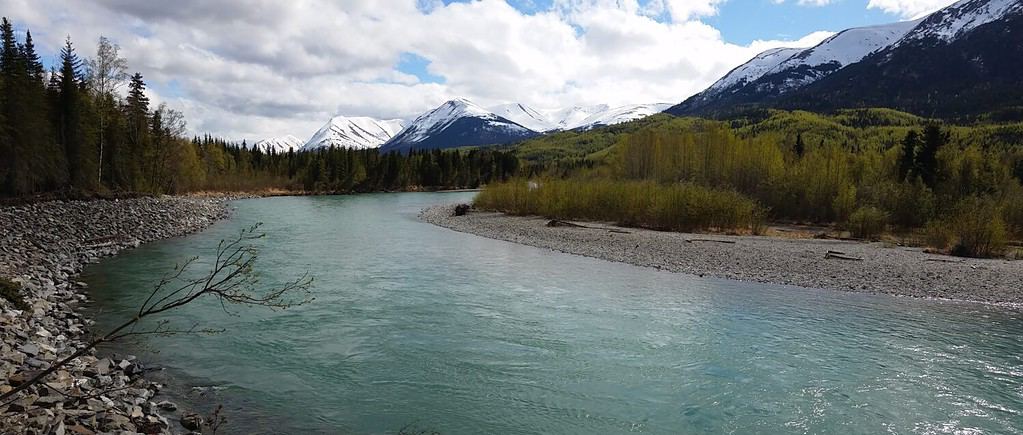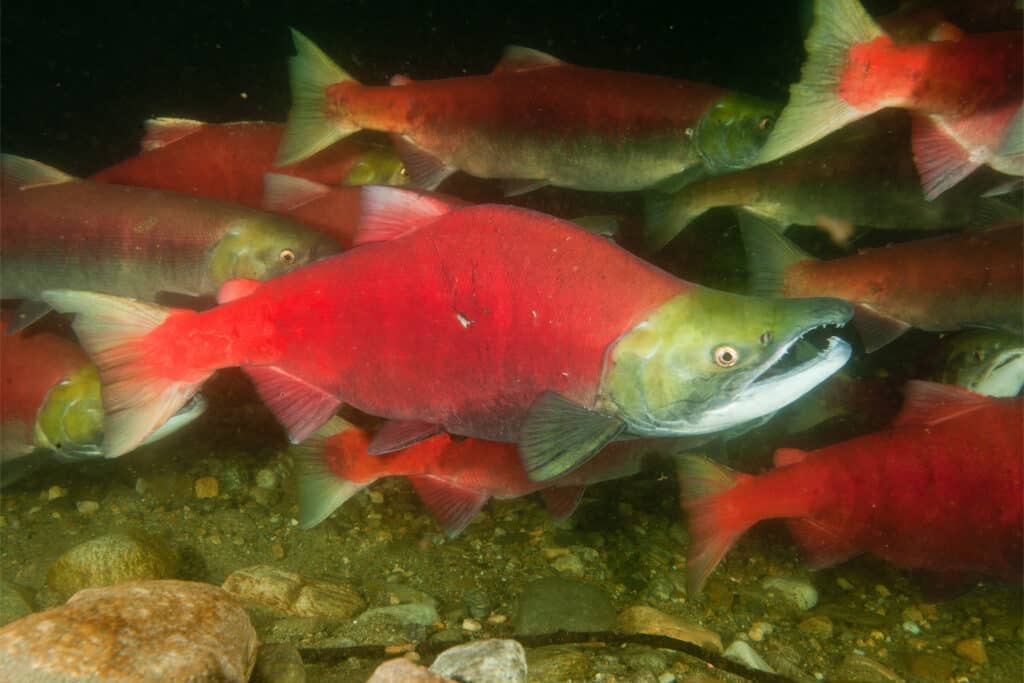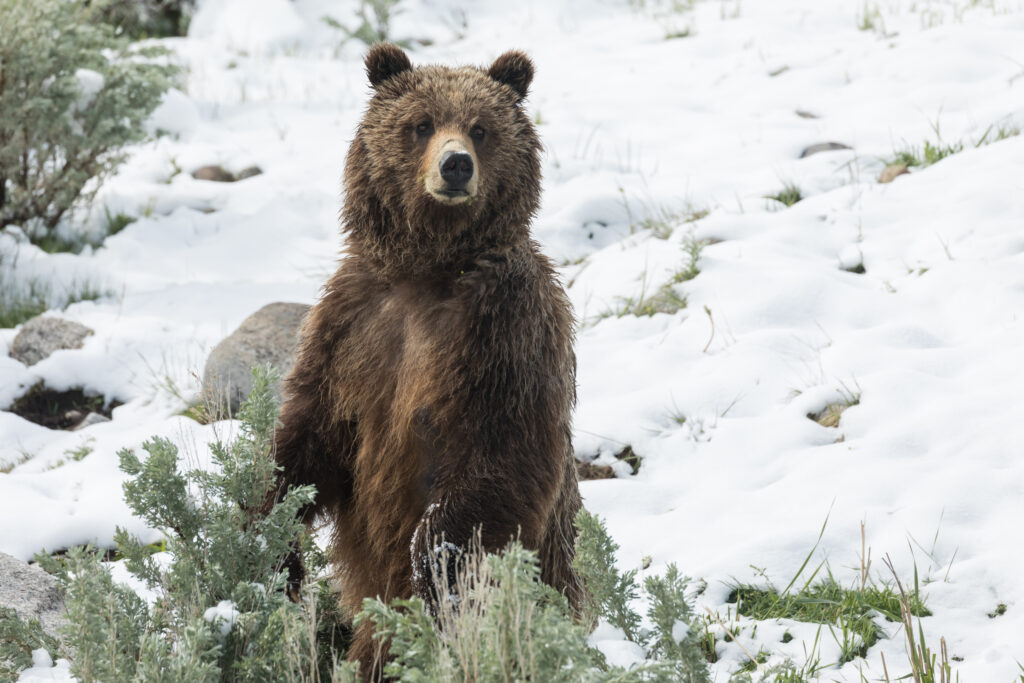Curious about what lifeforms live in and around the Copper River? From some of the healthiest populations of sockeye salmon to gorgeous grizzly bears, wildlife is teeming in and around this river.
So, what’s in the Copper River? Is it safe to swim in? If you’re planning a trip to this stunning Alaskan river, read on to learn about some of the amazing animals that call the Copper River Delta home and what risks you face if you’re thinking of taking a dip.
Overview of the Copper River
The Copper River is a significant body of water that runs 290 miles. Its headwaters begin at the Copper Glacier on the northeast side of Mount Wrangell in Southeastern Alaska. From this origin, it snakes along north, west, and south before finally turning in a southeastern direction and emptying into the Gulf of Alaska.
In the Ahtna language of the indigenous Alaskan people of the Copper River region, the river is most commonly called ‘Atna’tuu, meaning “river of the Ahtnas”. In the coastal Tlingit language, the river is also called Eeḵhéeni, translating as “river of copper”. The reference to copper comes from the large copper deposits that exist along the upper portions of the river.
Climate and Geography
The climate of the Copper River and surrounding region is subarctic continental characterized by long, cold winters and brief, mild summers. Prior to the 1970s, the Copper River routinely fully froze throughout the frigid Alaskan winters. However, in recent decades, due to climate change brought forth by industrial civilization, the Copper River rarely fully freezes. Still, it partially freezes every year with full freezes in some sections. On average, the temperature is -10 degrees Fahrenheit in this region during January. In July, the mean temperature in the Copper River region is about 56 degrees Fahrenheit. Annual snowfall tends to average 39-68 inches.
The Copper River passes through a range of landscapes, although it is largely defined by its river delta ecosystem. In smaller sections, it is bordered by rocky terrain, impressive sand dunes, and hilly conifer forests. From much of the Copper River, visitors can see the snowy, dramatic Wrangell-St. Elias mountain range rising sharply in the distance.

You can often see stunning views of the Wrangell-St. Elias mountain range from the gorgeous Copper River.
©Judith Baker/Shutterstock.com
What’s in the Copper River: Pollution Threats
While the Copper River is currently not impacted by heavy pollution, environmental activists have been working for years to establish a citizen oversight board to combat the enormous pollution threat posed by hundreds of miles of the Trans-Alaska Pipeline. This aboveground pipeline crosses five major tributaries to the Copper River. These tributaries are crucial spawning grounds for threatened species of salmon. Activists have been pointing out for years that the current response plans to an oil spill would allow significant pollution to travel over 25 miles downriver before being contained. The pipeline is one of many across the country threatening to or actively polluting waterways and lands. Oftentimes, these pipelines cut through or run extremely close to indigenous-held territories.
Environmentalists have immense reason to be concerned. In the last roughly 20 years, 9,784 barrels of oil have been spilled in 18 breaches of the Trans-Alaska Pipeline.
Critters Living in and Around the Copper River
Below, we’ll cover some of the marvelous animals that live in and around this gorgeous Alaskan river. While some of these animals pose little threat to people, our final critter demands the utmost of respect when traveling through its range.
Beaver
One delightful animal you may see on a trip to the Copper River is a beaver (Castor canadensis). These intriguing creatures live in healthy numbers along the Copper River Delta where they build their homes, hunt, and raise their young. Beavers are primarily nocturnal, spending most of their active hours between dusk and dawn. During the day, they tend to rest in their lodges that they build in the river or against the bank.
Alaska is home to some of the largest remaining populations of predators of beavers. Wolves, bears, coyotes, bobcats, and birds of prey roam the landscape. Humans also hunt beavers for food and pelts. As herbivores, beavers munch on aquatic plants as well as tree bark and twigs. If you visit the Copper River just at the break of dawn, you may spot beavers foraging plants as they swim through the river or meander along the banks.

Beavers enjoy a healthy population in the Copper River Delta.
©Frank Fichtmueller/Shutterstock.com
Sockeye Salmon
The Copper River hosts several species of salmon. However, sockeye salmon ( ), also known as Copper River salmon, account for over 90% of the general population. Sockeye salmon that have undergone a trip to the Pacific Ocean return with bright pink-red bodies. This is due to the krill and phytoplankton that comprise the vast majority of their ocean diet.
Many native tribes are deeply involved in protecting sockeye salmon populations across the rivers and coastal waters of Alaska. These fish are integral to the health of the larger Alaskan ecosystem which includes indigenous hunters.

Sockeye salmon account for over 90% of the general salmon population in the Copper River.
©Beat J Korner/Shutterstock.com
Grizzly Bear
Grizzly bears (Ursos arctus horribilis) frequent the Copper River to hunt and drink. In these waters, the bears are particularly keen on hunting salmon. In Alaska, brown bears that tend to reside inland are considered the smaller grizzly bear subspecies of the larger coastal brown bears (Ursos arctus).
Compared to black bears, grizzlies tend to be far more willing to engage in confrontation when they feel threatened. Bear biologists suggest that this may be due to black bears evolving in dense forests where climbing trees and hiding in the forest were ideal strategies. For the larger brown bears evolving in tundra and plains and being less equipped for climbing than black bears, being confrontational better suits their evolutionary strategy.
While you can often readily scare away an approaching black bear, confrontation is not a good strategy with brown bears. While there are 15 times more black bears than grizzlies in the U.S., grizzlies have killed twice as many people. This does not imply that they aren’t deserving of our admiration, respect, and efforts to protect their populations and habitats. It does mean, however, that hiking in areas frequented by grizzlies requires practicing good situational awareness and knowing ways to respond.

Grizzly bears visit the Copper River to hunt, drink, and teach their young how to catch fish.
©Kelp Grizzly Photography/Shutterstock.com
Safety Tips in Grizzly Bear Country
If you see a grizzly bear and are on foot, try to quietly and calmly back out of the area. If the bear notices you, avoid eye contact and continue to calmly back away. Finally, if you are faced with a grizzly who is aggressively approaching you, and you aren’t carrying bear mace capable of stopping the attack, immediately lie belly-down on the ground, cover your head with your hands, and create a wide stance with your legs to become harder to flip over. You can’t outrun a grizzly and running will only serve to increase the predatory drive of the bear.
Over half of the recorded attacks by grizzlies involve a mother bear with cubs. If you’re visiting Copper River in the spring or early summer, make sure to keep an eye out for cubs and immediately and quietly leave the area if you spot any.
What’s in the Copper River: Is it Safe to Swim in?
Two of the biggest threats that exist for swimming in this river are the cold water and encountering grizzly bears. But ultimately, the risk of hypothermia by swimming is the biggest risk you face by swimming in this river. Swimming in Copper River is generally discouraged by park services due to the cold water and ambient temperatures. Folks recreating via boat on this river are encouraged to wear a dry suit to prevent developing hypothermia if they fall in.
The photo featured at the top of this post is © Tomasz Wozniak/Shutterstock.com
Thank you for reading! Have some feedback for us? Contact the AZ Animals editorial team.






